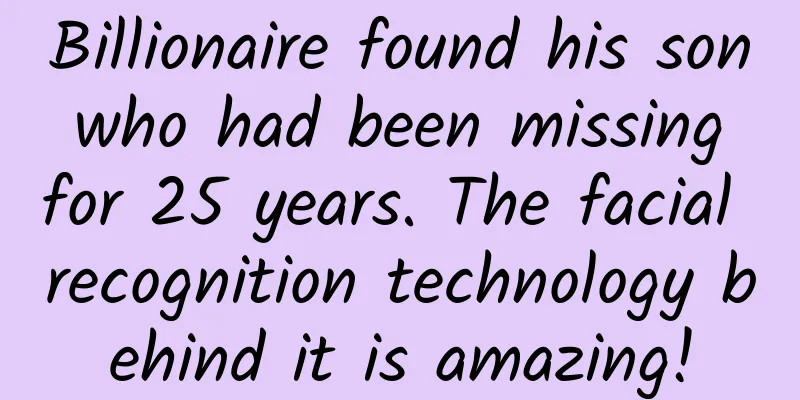Billionaire found his son who had been missing for 25 years. The facial recognition technology behind it is amazing!

|
A few days ago, a topic about "Billionaire finds his son who had been missing for 25 years" attracted attention from the entire Internet. In 1998, Xie Qingshuai was kidnapped when he was only 3 months old. His father searched for him till 25 years later, and finally the father and son were reunited. This time, Xie Qingshuai and his family were reunited thanks to a facial recognition company. The company's "cross-age and same-kinship face matching algorithm" matched Xie Qingshuai's parents and brother's facial images, and finally confirmed Xie Qingshuai's identity through DNA comparison. Image source: Screenshot from Sina Weibo The question is: What is the facial recognition technology used to find Jie Qingshuai? Is it the same technology we use to unlock our phones? Today, let’s talk about the past and present of facial recognition. From manual assistance to pure computer recognition 1. Define a person by physical characteristics As early as 1879, French criminologist Alphonse Bertillon invented a method to identify criminals or suspects: identifying a person by measuring 11 physical data, such as the length from the elbow to the end of the middle finger, the length of the right ear, the length of the left foot, etc. Alphonse's method for identifying human features, image source: wikimedia Although Alphonse's original intention was to identify bad guys, his idea of identifying a person based on their physical data characteristics was a great inspiration for subsequent facial recognition technology. 2. “Semi-automatic” face recognition In 1964, American mathematician and artificial intelligence expert Woody Bledsoe and others began to try to use computers to recognize human photos. The original idea was to take photos of faces from different angles and then let the computer learn the light and dark data on these photos to recognize a face. But considering the technical limitations at the time, this idea was simply not feasible. In the end, Woody and others chose a method similar to Alphonse's, looking for about 20 features on the human face, such as the width and spacing of the eyes, the length of the ears, the length of the corners of the mouth, etc., and defining a person by measuring the values of these features. However, computers at the time were unable to measure these data directly from photos, so Woody had to design a software that required people to manually input the measured data into the computer. The computer then compared them with the data in the database to identify who the face belonged to. This can be regarded as the earliest facial recognition software, but it is a "semi-automatic" method that requires human participation and can only process 40 pictures per hour. 3Fully automatic face recognition In the 1970s, Japanese scientist Takeo Kanade demonstrated a new facial recognition software that could automatically locate the chin, measure the face data, and identify the face. Although this software is still affected by factors such as shooting angle, light and shadow, and its recognition accuracy is limited, it has achieved an important transition from "semi-automatic" to "fully automatic". In the 1980s and 1990s, the emergence of methods such as Eigenfaces and Fisherfaces led to significant progress in fully automatic face recognition technology, and the recognition capability for static photos in controlled environments (such as ID photos) has become relatively reliable. For example, West Virginia and New Mexico in the United States have adopted facial recognition technology to identify faces on driver's licenses to prevent the same person from applying for multiple driver's licenses under different names. In 1997, Minnesota in the United States also began using facial recognition systems to identify criminals within the state. 4 Convolutional Neural Networks Bring a Leap Around 2010, deep learning technology based on convolutional neural networks brought about another leap in facial recognition technology. Convolutional neural network is a kind of neural network that imitates biological vision. Its architecture is very good at processing image information. People make various optimizations based on convolutional neural network, and can extract different types of information on the picture according to needs, such as light and dark, line contours, etc., so as to make a comprehensive judgment on the picture. Face recognition system. Image source: Reference [2] This method is somewhat different from Alphonse's previous method. It no longer recognizes faces based on specific numbers such as eye width and ear length, but directly recognizes faces based on overall facial features, which is more similar to the recognition process of animal vision. Around 2010, computer vision databases that can be used for deep neural network training became increasingly complete, such as ImageNet built by Fei-Fei Li and others, which contains tens of millions of manually annotated images. In addition, GPUs were applied to the field of deep learning around 2012, which greatly improved the speed and accuracy of face recognition technology. For example, in 2014, FaceBook's DeepFace facial recognition system was able to achieve an accuracy rate of 97.35%, which is almost the same as human recognition accuracy. In 2015, Google's FaceNet, which was proposed, had a facial recognition accuracy rate of 99.63% in some databases. Deepface face recognition system, Image source: Reference [3] To this day, facial recognition technology is still developing rapidly. In addition to being able to recognize static photos, it can also accurately and quickly recognize dynamic faces in video images. Ubiquitous facial recognition technology As the accuracy of face recognition increases, its applications in life are also increasing. For example, now almost all mainstream mobile phones support face recognition unlocking; when buying things in many convenience stores, you don’t need to take out your phone to open the payment code, you can just pay by face recognition; when entering and exiting the train station, you can also just scan your face to pass through the gate. In addition to these daily applications, face recognition systems also play an important role in some special fields. For example, since April 2018, at Jacky Cheung's concerts, security and surveillance cameras have successfully captured nearly 100 fugitives or criminal suspects, and netizens have joked that Jacky Cheung's concerts are simply "arrest meetings." In addition, in the Lao Rongji case, which caused great controversy in society, the facial recognition system easily identified Lao Rongji, who had been on the run for 23 years. Source: Screenshot of Xiamen police video As the accuracy of facial recognition technology becomes higher and higher in cross-age facial recognition and facial recognition with obstructed faces, facial recognition technology can also better protect our safety. The aforementioned "cross-age same-kin face comparison algorithm" is also an optimization of face recognition technology in a specific field. Such a function can not only find fugitive suspects after many years, but also be of great help to lost or abducted children in finding their biological parents. A facial recognition system based on kinship. Image source: Reference [4] It is worth noting that although AI facial recognition brings convenience to our lives and protects our safety, it also has some risks. For example, some apps on our mobile phones are using our facial data. Although most companies will try their best to ensure the security of this data, there are still some software developers who are unable to or have no intention of protecting data security at all, which may cause serious personal information leaks. For example, ClearviewAI, a company that provides services to US law enforcement agencies, has been exposed to data leaks. In addition, the company was also exposed to illegally collecting user photo information for training algorithms without user consent. In short, although facial recognition technology has a history of more than half a century, it has only entered a stage of rapid development and penetrated into all areas of life in the last decade or so. When facial recognition technology is used in the right place, it does bring convenience and security to our lives and allows families who have been separated for many years to be reunited. But while enjoying the convenience of technological development, we must also enhance our awareness of privacy and try to avoid using our photos and videos on unknown mini-programs to reduce the possibility of information leakage. References [1]AdjabiI,OuahabiA,BenzaouiA,etal.Past,present,andfutureoffacerecognition:Areview[J].Electronics,2020,9(8):1188. [2] Wang Liang, Huang Yongzhen, Zhang Kaihao. A method and device for face kinship recognition based on convolutional neural network, CN105005774A, 2019-02-19 [3]TaigmanY,YangM,RanzatoMA,etal.Deepface:Closingthegaptohuman-levelperformanceinfaceverification[C]//ProceedingsoftheIEEEconferenceoncomputervisionandpatternrecognition.2014:1701-1708. [4]RobinsonJP,ShaoM,WuY,etal.Familiesinthewild(fiw):Large-scalekinshipimagedatabaseandbenchmarks[C]//Proceedingsofthe24thACMinternationalconferenceonMultimedia.ACM,2016:242-246 This article is a work of Science Popularization China-Starry Sky Project Produced by: Science Popularization Department of China Association for Science and Technology Producer|China Science and Technology Press Co., Ltd., Beijing Zhongke Xinghe Culture Media Co., Ltd. Author: Science Scraps Popular Science Creation Team Review丨Yu Yang, Head of Tencent Xuanwu Lab |
>>: Can you reach this pace? Diabetes risk may be reduced by 39% →
Recommend
Are you really not fat? Is it possible that you are an "invisible fat person"?
Statement: This article is a medical-related educ...
Android Accessibility Kit welcomes Camera Switches: Control your phone with facial expressions
[[417832]] There are many accessibility features ...
A comprehensive review of online education live broadcast operation skills
" Online education " and "live str...
Make no mistake! Baking soda, baking soda, and baking soda all have their own magical properties!
As an office worker, I just want to rest in bed w...
You can advertise without money. These tricks can cut your marketing costs by half!
Is it possible to advertise without money? Before...
So ugly! So smelly! You read that right, I'm talking about orchids
Everyone is familiar with orchids, such as this o...
Perfect Diary’s Methodology for Explosive Products
Brands such as Perfect Diary , Hua Xizi, and Cha ...
What is the principle behind the magical “re-icing phenomenon”?
Science Fiction Network, January 5 (Jin Kaiyi) Pu...
6 core concepts of community operation!
I recently reread Professor Xu Zhibin’s "The...
Analysis of 6 popular brand marketing cases!
Internet restructuring, new moves for brands. Viy...
Top 5 marketing trends in the fourth quarter of 2021!
Where do new brands attract new users? What actio...
Fill in the blanks! Enter the "water dungeon"!
On March 19, my country's first seabed carbon...
Are Chinese characters so magical that they do not affect reading even if they are read upside down?
This article was reviewed by Dr. Tao Ning, Associ...
How does event planning create a hit?
Organizing activities is a good choice. It can in...
The “nemesis” of forest fires: How do wind-powered fire extinguishers demonstrate their power?
In the prevention and fighting of forest fires, p...









